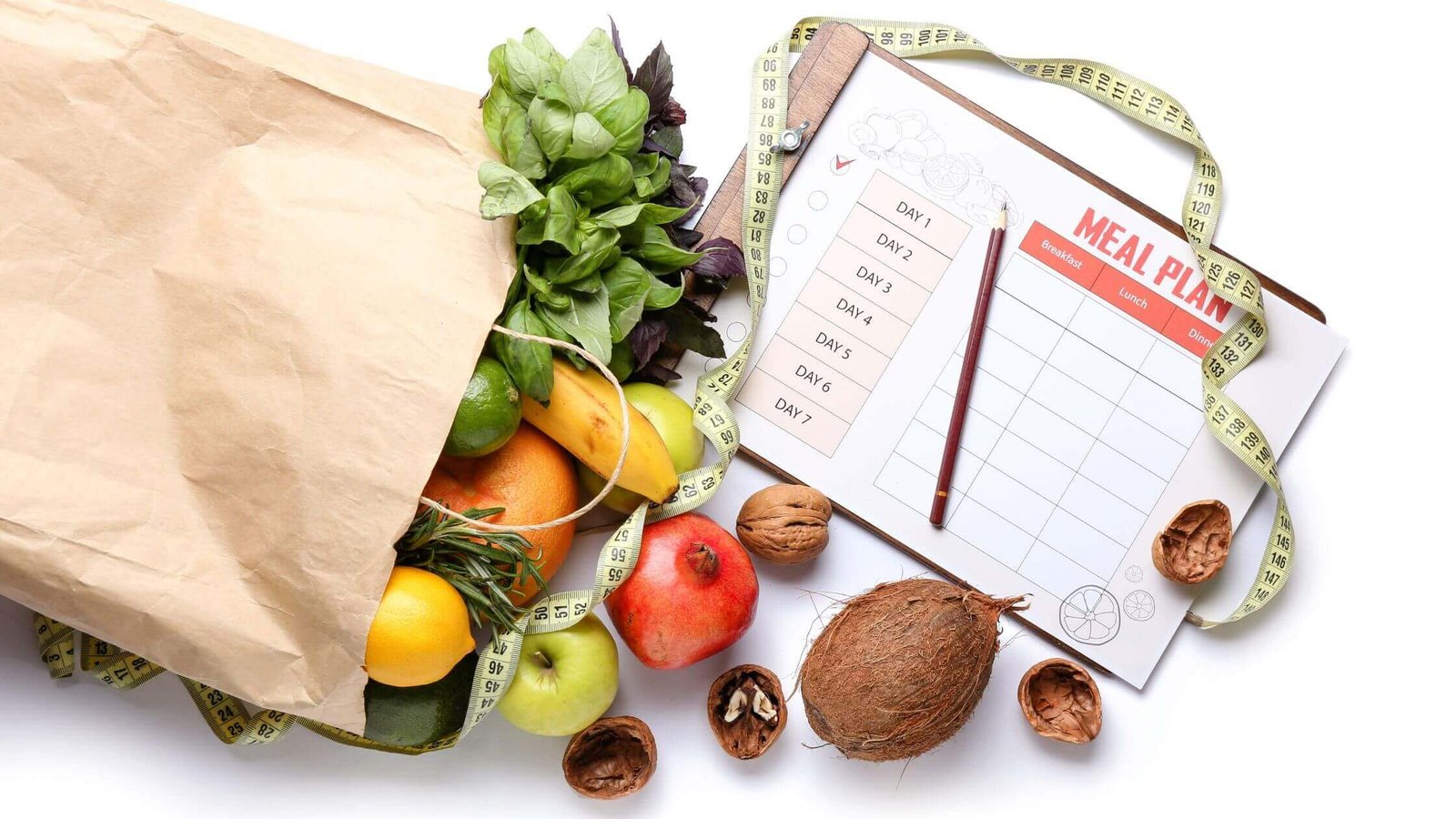Meal Planning for Busy People: A Comprehensive 101 Guide

Meal preparation is sometimes neglected in today’s hectic society due to competing priorities such as work, family, and other commitments. People who are constantly on the go often choose unhealthy options like fast food or takeaway.
A solution to this problem is meal planning, which allows busy people to eat well without the hassle and time commitment of cooking every day. In this in-depth post, we’ll explore the many advantages of meal planning and provide you with a detailed guide to help you fit it into your hectic schedule.
The Advantages of Meal Planning for Busy People
Meal planning is a powerful strategy that can bring numerous benefits to your life. Here are some of the key advantages:
1. Time Efficiency
The time it saves is one of the most significant advantages of meal planning. The time and energy you spend in the kitchen each day can be reduced if you have a plan for what you want to create in advance. Those with busy schedules will appreciate the time they gain by planning ahead for dinner, as this eliminates the need for last-minute runs to the supermarket and a rushed meal.
2. Financial Savings
Meal planning minimizes food waste by only purchasing the ingredients needed for your planned meals. This, in turn, can lead to substantial cost savings compared to impulsive grocery shopping and dining out. The careful planning of your meals allows you to take advantage of sales, discounts, and bulk purchases, further reducing your overall food expenses.
3. Improved Nutrition
Meal preparation gives you the chance to think about what you’re eating and pick out nutritious options. Reduce your intake of processed and unhealthy foods and increase your intake of fresh produce, lean meats, and whole grains. Meal planning is a great way to make sure you’re getting the nutrients you need, especially if you have dietary limitations or preferences.
4. Reduced Stress
The daily “What’s for dinner?” dilemma can be a significant source of stress, especially for those leading busy lives. Meal planning eliminates this uncertainty, reducing the stress associated with mealtime decision-making. Instead of scrambling to figure out what to eat at the last moment, you can relax, knowing that your meals are already planned and ready to be prepared.
5. Portion Control
Planning your meals helps you keep your amount sizes in check, which is an important part of eating and staying at a healthy weight. You can avoid overeating and make sure you’re getting the right number of calories for your goals by planning your portions ahead of time and sticking to them.
Getting Started with Meal Planning
Meal planning might seem like a daunting task, especially if you’ve never tried it before. However, with the right approach and some helpful tips, you can easily incorporate this practice into your daily routine. Here’s how to get started:
1. Define Your Goals
Think about your lifestyle, your obligations, and your meal planning goals. Are you planning dinners every day, lunches during the week, or meals for the whole week? Start with a plan that is reasonable, and as you get more comfortable, add to it. Remember that the meals you plan should fit your specific wants and circumstances.
2. Create a Weekly Menu
Determine which meals you want to plan. Common choices include breakfast, lunch, and dinner, with snacks in between. Start with a basic menu and add complexity as you become more experienced in meal planning. For instance, you might begin by planning dinners for a week and gradually incorporate breakfast and lunch into your routine.
3. Recipe Selection
Make sure the recipes you choose fit into your schedule and are both healthful and appropriate for your menu. Take into account elements like the quantity of ingredients and the cooking time. Choose easy recipes with little prep if you’re a novice chef or don’t have much time. You can try with more complicated meals as you gain skill and confidence.
4. Prepare a Shopping List
After selecting your recipes, create a detailed shopping list. Check your pantry and fridge for any items you already have to avoid redundancy. An organized shopping list is crucial for a successful meal planning experience, as it ensures you have all the necessary ingredients on hand.
5. Preparation in Advance
Once you’ve completed your shopping, spend some time prepping ingredients. Wash and chop vegetables, marinate meats, and store them in containers. This can significantly reduce cooking time and effort during the week. Meal prep not only saves time but also simplifies your daily cooking process, making it more convenient.
6. Storage Containers
Invest in quality storage containers for storing prepared meals. These containers can help you maintain portion control and keep your meals fresh. Opt for containers that are microwave-safe and freezer-friendly, as they provide the flexibility to store and reheat your meals as needed.
7. Flexibility
Even though planning is crucial, be ready for unforeseen alterations to your itinerary. There will be days when your strategy needs to be adjusted because life can be unpredictable. Keep some frozen meals or backup plans on hand in case you run out of time to prepare meals. Being able to choose from a variety of ready-made, nutrient-dense options makes sure you don’t turn to junk food substitutes.
8. Batch Cooking
When you have free time or the weekends, think about cooking in bulk. This tactic entails cooking more of some foods so they may be portioned out and frozen for later use. Because you’ll have prepared meals available whenever you need them, batch cooking can help you save time and effort throughout the week. Grains like rice and quinoa, as well as soups, stews, and casseroles, are among dishes that work well for batch cooking.
9. Variety Is Key
Avoid mealtime monotony by rotating your recipes. Experiment with new dishes and flavors to keep your meal plans exciting. Exploring a variety of cuisines, cooking techniques, and ingredients can make your meals more enjoyable and prevent culinary burnout.
Adapting Meal Planning to Your Lifestyle
Meal planning is a versatile approach that can be adapted to various lifestyles and dietary preferences. Here are some tips for incorporating meal planning into different scenarios:
For Working Professionals
- Plan your lunches and snacks to ensure that you have nutritious meals at the office or on the go.
- Choose recipes that are quick to prepare and easy to transport, such as salads, sandwiches, and wraps.
- Consider investing in a bento box or airtight containers to keep your work lunches fresh and organized.
For Families
- Involve family members in the meal planning process to accommodate their preferences and dietary requirements.
- Create a shared family calendar for meal planning, allowing everyone to contribute their ideas and suggestions.
- Designate specific days for family favorites or theme nights, such as “Taco Tuesdays” or “Pizza Fridays.”
For Fitness Enthusiasts
- Plan your meals to align with your workout schedule and nutritional goals.
- Ensure that your meals provide the necessary macronutrients, such as protein, carbohydrates, and healthy fats, to support your fitness regimen.
- Consider meal prep for post-workout snacks or protein-packed lunches to aid in muscle recovery.
For Special Dietary Needs
- Tailor your meal planning to accommodate dietary restrictions or preferences, such as vegetarian, vegan, gluten-free, or low-carb diets.
- Explore specialized cookbooks and online resources that offer recipes and meal plans tailored to your dietary needs.
- Keep an eye out for ingredient substitutions that align with your dietary requirements.
Meal Planning Tools and Resources
To make the meal planning process more accessible and efficient, consider using various tools and resources:
Meal Planning Apps
Several meal-planning apps are available for both smartphones and computers. These apps often include features such as recipe storage, automated shopping lists, and nutritional information. Popular meal planning apps include Mealime, Paprika, and Plan to Eat.
Cookbooks
Cookbooks are a great source of food ideas and meal planning inspiration. Look for cookbooks that highlight particular cultures, one-pot recipes, or quick and simple dinners. A lot of cookbooks also include effective meal preparation advice.
Online Recipe Websites
The internet is a treasure trove of recipe websites that offer a vast selection of dishes to incorporate into your meal plans. Websites like AllRecipes, Food Network, and Epicurious feature user-rated recipes and search filters for specific dietary needs.
Cooking Magazines
Cooking magazines often feature seasonal recipes and meal-planning tips. Consider subscribing to a cooking magazine or exploring their online counterparts for fresh meal ideas.
Maintaining a Healthy Meal Plan
While the initial setup of a meal plan is crucial, it’s equally important to maintain a sustainable and healthy meal planning routine. Here are some tips for long-term success:
Regularly Review and Update Your Plan
As your circumstances change or your culinary preferences evolve, take the time to review and update your meal plan accordingly. Periodically assess your meal planning goals and make adjustments as needed.
Embrace the Concept of Leftovers
Leftovers can be a meal planner’s best friend. Instead of viewing them as mundane repeats, think of leftovers as a convenient way to save time and reduce food waste. Reinvent leftovers into new dishes or enjoy them as quick, no-fuss meals.
Experiment and Expand Your Repertoire
Meal planning offers an excellent opportunity to experiment with new recipes and cuisines. Be open to exploring different cooking techniques and ingredients to keep your meal plans exciting and enjoyable.
Seek Support and Inspiration
Joining online communities or social media groups focused on meal planning can provide support, inspiration, and a sense of community. You can share your meal planning experiences, discover new recipes, and learn from others who share your passion for nutritious, home-cooked meals.
Adapting Meal Planning to Dietary Preferences
Meal planning can be seamlessly tailored to a variety of dietary preferences, including:
For Vegetarians and Vegans
- Explore plant-based protein sources such as beans, lentils, tofu, and tempeh.
- Incorporate a wide variety of vegetables, fruits, and whole grains into your meal plans.
- Explore vegan and vegetarian cookbooks and online resources for recipe ideas.
For Low-Carb Dieters
- Opt for recipes that feature lean protein sources and non-starchy vegetables.
- Limit or eliminate high-carb ingredients such as bread, pasta, and rice.
- Explore low-carb cookbooks and websites for meal planning inspiration.
For Gluten-Free Diets
- Choose naturally gluten-free grains like rice, quinoa, and corn for your meal plans.
- Verify ingredient labels to ensure that packaged foods are gluten-free.
- Consider using gluten-free flour substitutes for baking and cooking.
For Keto Diets
- Focus on high-fat, low-carb recipes that include sources of healthy fats such as avocados, nuts, and olive oil.
- Limit your carb intake to a specific daily target, typically around 20-50 grams of net carbs.
- Explore keto cookbooks and online resources for meal planning ideas.
For Weight Loss
- Calculate your daily calorie needs and adjust your portion sizes accordingly.
- Choose recipes that are lower in calories and incorporate lean protein and high-fiber ingredients.
- Monitor your progress and adjust your meal planning to support your weight loss goals.
Meal Planning for Specific Lifestyles
Meal planning can be tailored to specific lifestyles and needs. Here are some tips for different scenarios:
For Working Professionals
- Plan your lunches and snacks to ensure that you have nutritious meals at the office or on the go.
- Choose recipes that are quick to prepare and easy to transport, such as salads, sandwiches, and wraps.
- Consider investing in a bento box or airtight containers to keep your work lunches fresh and organized.
For Families
- Involve family members in the meal planning process to accommodate their preferences and dietary requirements.
- Create a shared family calendar for meal planning, allowing everyone to contribute their ideas and suggestions.
- Designate specific days for family favorites or theme nights, such as “Taco Tuesdays” or “Pizza Fridays.”
For Fitness Enthusiasts
- Plan your meals to align with your workout schedule and nutritional goals.
- Ensure that your meals provide the necessary macronutrients, such as protein, carbohydrates, and healthy fats, to support your fitness regimen.
- Consider meal prep for post-workout snacks or protein-packed lunches to aid in muscle recovery.
For Special Dietary Needs
- Tailor your meal planning to accommodate dietary restrictions or preferences, such as vegetarian, vegan, gluten-free, or low-carb diets.
- Explore specialized cookbooks and online resources that offer recipes and meal plans tailored to your dietary needs.
- Keep an eye out for ingredient substitutions that align with your dietary requirements.
Meal Planning Tools and Resources
To make the meal planning process more accessible and efficient, consider using various tools and resources:
Meal Planning Apps
Several meal planning apps are available for both smartphones and computers. These apps often include features such as recipe storage, automated shopping lists, and nutritional information. Popular meal planning apps include Mealime, Paprika, and Plan to Eat.
Cookbooks
Cookbooks provide a wealth of recipe ideas and inspiration for meal planning. Look for cookbooks that focus on quick and easy meals, one-pot recipes, or specific cuisines. Many cookbooks also offer tips for efficient meal preparation.
Online Recipe Websites
The internet is a treasure trove of recipe websites that offer a vast selection of dishes to incorporate into your meal plans. Websites like AllRecipes, Food Network, and Epicurious feature user-rated recipes and search filters for specific dietary needs.
Cooking Magazines
Cooking magazines often feature seasonal recipes and meal-planning tips. Consider subscribing to a cooking magazine or exploring their online counterparts for fresh meal ideas.
Maintaining a Healthy Meal Plan
While the initial setup of a meal plan is crucial, it’s equally important to maintain a sustainable and healthy meal planning routine. Here are some tips for long-term success:
Regularly Review and Update Your Plan
As your circumstances change or your culinary preferences evolve, take the time to review and update your meal plan accordingly. Periodically assess your meal planning goals and make adjustments as needed.
Embrace the Concept of Leftovers
Leftovers can be a meal planner’s best friend. Instead of viewing them as mundane repeats, think of leftovers as a convenient way to save time and reduce food waste. Reinvent leftovers into new dishes or enjoy them as quick, no-fuss meals.
Experiment and Expand Your Repertoire
Meal planning offers an excellent opportunity to experiment with new recipes and cuisines. Be open to exploring different cooking techniques and ingredients to keep your meal plans exciting and enjoyable.
Seek Support and Inspiration
Participating in meal planning-related social media groups or online communities can offer encouragement, support, and a feeling of connection. You can learn from individuals who share your enthusiasm for wholesome, home-cooked meals, exchange meal planning experiences, and discover new recipes.
Adapting Meal Planning to Dietary Preferences
Meal planning can be seamlessly tailored to a variety of dietary preferences, including:
For Vegetarians and Vegans
- Explore plant-based protein sources such as beans, lentils, tofu, and tempeh.
- Incorporate a wide variety of vegetables, fruits, and whole grains into your meal plans.
- Explore vegan and vegetarian cookbooks and online resources for recipe ideas.
For Low-Carb Dieters
- Opt for recipes that feature lean protein sources and non-starchy vegetables.
- Limit or eliminate high-carb ingredients such as bread, pasta, and rice.
- Explore low-carb cookbooks and websites for meal planning inspiration.
For Gluten-Free Diets
- Choose naturally gluten-free grains like rice, quinoa, and corn for your meal plans.
- Verify ingredient labels to ensure that packaged foods are gluten-free.
- Consider using gluten-free flour substitutes for baking and cooking.
For Keto Diets
- Focus on high-fat, low-carb recipes that include sources of healthy fats such as avocados, nuts, and olive oil.
- Limit your carb intake to a specific daily target, typically around 20-50 grams of net carbs.
- Explore keto cookbooks and online resources for meal planning ideas.
For Weight Loss
- Calculate your daily calorie needs and adjust your portion sizes accordingly.
- Choose recipes that are lower in calories and incorporate lean protein and high-fiber ingredients.
- Monitor your progress and adjust your meal planning to support your weight-loss goals.
Meal planning for busy people is a flexible and adaptable strategy that can be personalized to suit your dietary preferences and lifestyle. Whether you’re following a specific diet, pursuing weight loss, or simply seeking convenient and nutritious meal solutions, meal planning can be a valuable tool to help you achieve your culinary goals.
In Conclusion
The planning of meals is not just the purview of homemakers or foodies. It is an approachable, effective, and useful method for everyone with a busy schedule. You can save money on eating out, take back control of your diet, and save time by making meal planning a regular part of your routine.
Meal planning can completely change the way you think about food, whether you’re a working mom, student, or professional with a busy schedule. Begin cautiously, make thoughtful plans, and relish the rewards of a well-organized and nutritious food adventure. Accept meal planning and witness the change it brings to your life, which will make your body and palate very happy.






